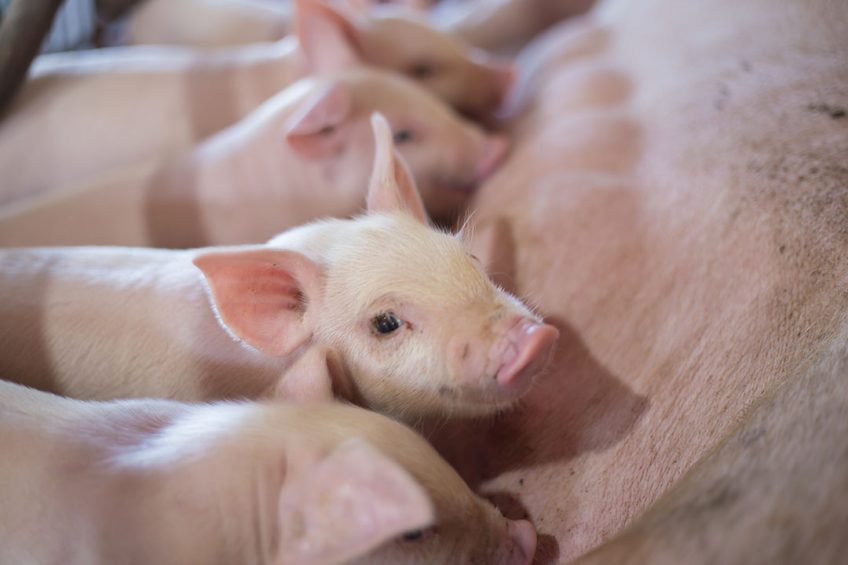Sow feed intake and its effect on litter uniformity

The modern hyperprolific sow has been bred to produce large litters of fast-growing piglets. However, consumer demand for lean meat has also led to the selection of a sow that carries less body reserves in the form of fat and often has an appetite insufficient to drive adequate feed intake to support sow and litter in the farrowing house.
Feed intake during lactation is critical to ensure the sow can satisfy the nutritional needs of her growing litter. On commercial units achieving adequate feed intakes during this period is often a challenge, particularly during the later stages of lactation when demand for milk by the growing litter is high or in situations of heat stress when feed intake is depressed. Insufficient sow feed intake in this period will result in less milk being produced leading to smaller litters of lighter pigs at weaning.
Supporting the piglet
Achieving high weaning weight is crucial for productivity and profit of a pig enterprise. Lighter piglets at weaning are more likely to eat less or not at all in the first days after weaning. This leads to detrimental effects that influence performance over the life of the pig. Starting with an increased likelihood of developing diarrhoea due to the negative effects of stress at weaning and the lack of feed intake on gut development and health. Weaning weight can also influence performance throughout the production cycle; several studies have shown, that a reduction in feed intake the first week to 10 days after weaning can increase the time to slaughter weight by up to 10 days in severe cases.
Many interventions to support the piglet during this period have been introduced to make up this nutritional deficit. Creep feeding and liquid milk replacers can provide the piglet with additional nutrition although these practices require careful attention to unit management and husbandry to avoid hygiene problems. It has also been observed that the larger piglets consume the most milk and tend to have a higher creep feed intake rather than the smaller undernourished pigs in the litter, who would benefit most.
Supporting the sow
For the sow there are several factors that can influence feed intake during lactation; body condition at farrowing and feed intake during gestation can influence feeding pattern at the start of lactation. The effects of heat stress are seen at temperatures over 22oC with sows reducing feed intake to limit the heat generated by the metabolic process of digestion. Water and feed availability, quality and presentation (pellets or meal, wet or dry) will all influence feed intake
The sow is incredibly sensitive to taste and it has been proposed that diet palatability can have a positive influence on feed intake. To investigate this, a trial was conducted using hyperprolific sows assigned to 2 treatments, (T1) a control diet and (T2) the control diet with 500g of an appetite stimulant added (Krave AP), with 100 sows per treatment. Litter size was standardised to 15 piglets by cross fostering within 48 hours after farrowing. Pigs were weaned at 23 days and no creep feed was offered.
Results of sow performance are shown in Table 1. The significant increase in feed intake for the sows receiving the appetite stimulant led to greater milk production whilst allowing the sows to maintain body weight and backfat thickness at weaning. Weaning to oestrus interval was found to be the same as the control group indicating that this increase in milk production was not at the expense of body condition.
Figure 1 – Piglet weight distribution.

Piglets from the sows receiving the appetite stimulant had significantly higher average weaning weights than the control groups and weight distribution for all piglets (Figure 1). The effect of the treatment on weaning weight variation within litters is shown in Figure 2 and was dramatic with 90% of piglets weighing over 6kg at weaning for the appetite stimulant group compared with 41% of piglets in the control group.
Conclusion
Adding Krave AP to the diet of lactating sows improved litter liveweight and uniformity at weaning, whilst maintaining sow body condition. Weaning weight has a significant influence on the subsequent performance and the efficiency of the growing pig. Maintaining body condition at weaning can have a positive influence on sow reproductive performance and longevity. All of which are factors that contribute to a productive and profitable pig unit and are benefited by the simple addition of Krave AP to lactation feed.
Author: Simon Eskinazi, Global Scientific and Technical Manager Palatability, Adisseo
References are available upon request






